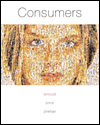This chapter examines how individual consumers make choices. A variety
of settings are explored to highlight the kinds of choices that consumers make.
Some choices involve a lot of thought, deliberation, and effort. Other choices
are almost automatic and don't require much effort (e.g., low involvement decisions,
making quick choices). A variety of theories and models are introduced to describe
consumer choice behavior. Attitudes are a product of information acquisition, and they reflect how
consumers think and feel. In a sense, attitudes are "learned". As
such, learning theories (e.g., operant conditioning, classical learning) can
be used to understand the process of attitude formation. People form attitudes
for four reasons: utilitarian function, value-expressive function, ego-defensive
function, and knowledge function. In addition, people can form attitudes toward
a number of "objects," including: other people, brands, products,
themselves, advertisements, and stores. Important attitude concepts include:
cognitions, affect, and behavior. These concepts can be combined into three
competing hierarchy of effects models, including the standard hierarchy, the
low-involvement hierarchy, and the experiential hierarchy. Each is appropriate
for understanding a different kind of consumer decision-making. Hierarchy-of-effects
models display a Western cultural bias and other models may be needed to explain
attitude formation in non-Western cultural environments. A number of attitude models and theories are introduced to describe how
consumers make choices. The four theories discussed are: the theory of cognitive
dissonance, self-perception theory, social judgement theory, and balance theory.
The two main attitude models are the multi-attribute model and the Elaboration
Likelihood Model. Two widely applied multi-attribute models are the Fishbein
Model and the Fishbein Extended Model. The main components of the former are
beliefs and their evaluations. The latter model is called the theory of reasoned
action and adds in components of the social world, including motivation to comply
and personal normative beliefs. A main managerial implication of attitudes is the process of persuasion,
as marketers and advertisers are interested in convincing consumers to try their
brands. The Elaboration Likelihood Model describes two routes to persuasion--the
central route to persuasion and the peripheral route. Under the central route,
consumers pay attention to "main message" arguments. Under the peripheral
route, consumers attend to secondary cues like music (or weaker arguments).
In different cultural contexts what counts as central and peripheral cues for
consumers may vary. Several Choice Models are discussed here: Expected Utility Theory, Consumer
Heuristics including Satisficing Decisions, and Prospect Theory. Expected Utility
Theory provides an idealized description of how consumers choose. Consumers
are hyphothesized to select the alternative that maximizes utility, subject
to certain constraints. In marketing research, we use conjoint analysis to understand
how consumers make trade-offs between two or more relevant attributes. Two contrasting descriptions of consumer decision making are compensatory
and non-compensatory models. In the former, a high score on one can compensate
a low score on another attribute. In non-compensatory models, there is no compensation.
Consumer heuristics describe short-cuts that consumers make to save time and
effort. Examples of consumer heuristics include: non-compensatory models, inference
making, and list making. Satisficing too presents a short-cut alternative to
"utility maximization." It describes how consumers are often satisfied
with choices that are "good enough." Prospect Theory, through the concept of value function, describes the different
ways that consumers perceive gains and losses. In general, losses "loom
larger" than gains. What this means in practical terms is consumers resist
giving up things that they already own, and that gives rise to the endowment
effect. |




 2002 McGraw-Hill Higher Education
2002 McGraw-Hill Higher Education